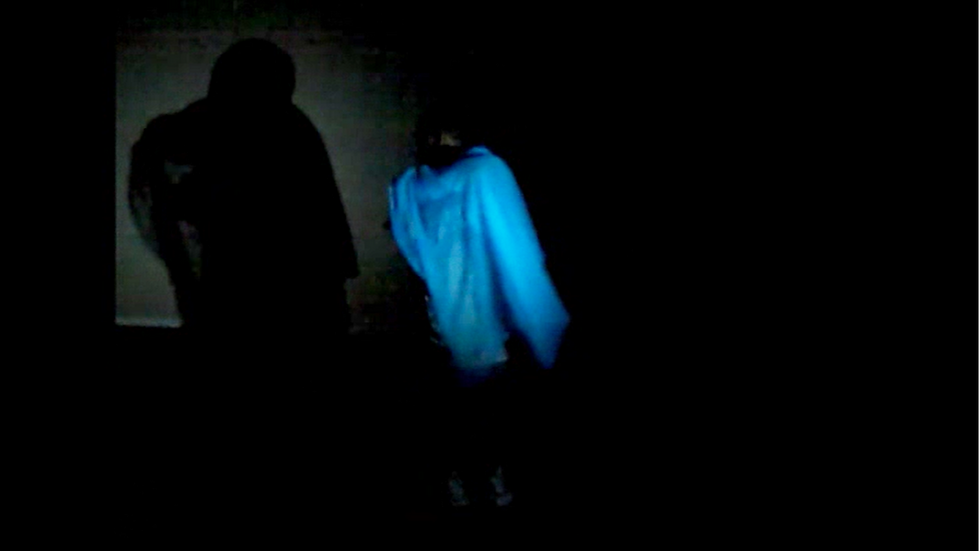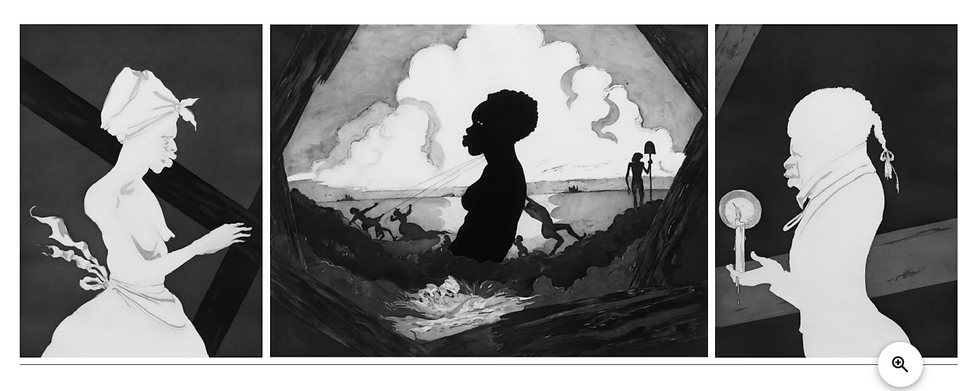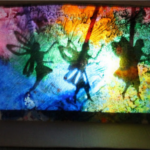Light, Dark and Shadow: Living through Art and Drama during COVID-19
- wellbeingsstudio

- Nov 5, 2020
- 5 min read

I remember the day my hair started falling out. I finished an oncology appointment and was standing outside waiting for my ride. I had already buzzed my hair short in preparation. It had taken me several looks in the mirror to grow accustomed to my face without a full head of hair. I knew it would fall out. But I wasn’t prepared for the shock of holding clumps in my hand. I stood over the trash can, and ran my fingers over my scalp. I watched the hair drift downward and disappear. I was in a new world. I was neither myself from before nor someone completely new. I was, as my daughter called me, “old mommy/new mommy.”

During breast cancer, I learned in stark relief that life isn’t a set of binaries. We don’t experience things as one or the other: healthy/sick, black/white, girl/boy, young/old, sweet/sour. Instead we live on a continuum. It does little good for me to see myself as either healthy or sick. I was both. I still am. I suffer from chronic pain, depression and anxiety. Some as a result of cancer treatment, some lingering since childhood. When I see myself as either/or, I reduce my experience and the meaning within each moment of my life. So I meditate on the both/and. On light, dark, and shadow. I work on reframing my thoughts.
How can I see myself complexly? How can I see others for their nuanced, prismatic meaning rather than fitting them into simplistic, overgeneralized categories?
And, why does this matter now, during the COVID-19 pandemic?
Staying at home, in isolation, children and teens are struggling. No intimate contact from friends, no traditional school day to structure the time. They may be thinking: I am alone; I am not in community. I am struggling with distance learning; I am not a good student.
Reframing the either/or can help us see things in a new, more complex way. We are alone, and we are participating in a global effort to beat the virus. (Now let’s go Zoom with friends and do a treasure hunt!) It’s ok to struggle with learning, learning is about growing rather than getting good grades. (Now let’s do a no-grades-in-fourth-quarter dance!) Life is full of gray.
This post shares my observations about the power of both/and: enjoying the grays; living in light, dark, and shadow; finding our rich humanity.
Shadow Dance

Shadow dance. Orit Krug, Dance movement therapist, 2010.
Dance and movement therapist Orit Krug discusses the power of dancing in shadows created by a flashlight in a dimly lit room or outside at dusk. We can use a flashlight to play with power, making our bodies appear in new shapes and sizes. We can make sounds as we grow and shrink. The mystery of moving in shadows becomes a new site to explore ourselves. Do this dance alone and with others. When we move in shadow together, we see each other. We can even join hands during a flashlight dance, creating new connection.
Shadow Doodles
@shadow_doodles_ Instagram.
I love this idea, thanks to Shadow Doodles. Find objects, place them on a piece of paper, and and shine light on them from different vantage points. What drawing can you create from the shadows? Talk about the drawings, even tell stories with them!
Shadow Poses

Survivor. Sharon Chappell, 2019.
Like shadow dances, shadow poses are a powerful way to convey a feeling or an idea about ourselves. I photographed myself in this pose after completing surgery, chemotherapy and radiation. I was struggling with my hormone medication, but so happy to be alive. Old mommy/new mommy.
We can try different poses and give the poses names. Take a photo, or have someone trace your shadow and create a chalk painting from it. Trace the shadows created by other things (dinosaur figures, your doll, a tree. Look for shadows on a walk. The possibilities are endless as we embrace the world’s shadows.
Shadow Puppetry
Left, Dragon puppet. Middle, Fairies on wax crayon resist background. Right, Ellie Kurttz.
Shadow puppetry is one of my favorite ways to explore the power of light. We can use this art form scientifically to examine how light is reflected, transformed or transmitted through an object. (Let’s watch! What is translucent, opaque and transparent in this shadow show?) We can also approach this art form socially and therapeutically. How is the puppet and its play an extension of me? A reflection of the world?
I love Peep and the Big, Big World’s simple take on making monster shadow puppets. Try all different shadow play today.
Painting Value
Bats, by Elementary Students. All the Arts for All the Kids, Fullerton School District.
In art, value shows us the visual gradients from light to dark. Mixing black and white together (adding increasing amounts of black to a pool of white paint) helps us see the impact of light and shadow on the environment. Value also helps to create emphasis and meaning. We can ask about where the focus is in a painting by looking at the range of light, dark and grays. We can talk about the social value of seeing complexity, rather than either/or categories. We can examine stereotypes of whiteness and blackness, and how those manifest in art, such as racial biases in photography.
Featured Artist: Kara Walker

Resurrection Story with Patrons. Kara Walker, 2017.
The Museum of Fine Arts, Houston, museum purchase funded by Bill Pritchard, Ralph Eads, Tony Petrello, Gary Petersen, and Doug Schnitzer at “One Great Night in November, 2017”
Kara Walker is a California-born artist who uses the classic Victorian style silhouette art to comment on intersections of race, gender, and sexuality in history and contemporary life.
COVID-19 Flashpoint: Racial Disparity in Patients
When we all see justice, then we’ll all see peace.
Michael Franti, “Same as It Ever Was (Start Today)”Across the country, news media are now reporting a new manifestation of racial and economic injustice during COVID-19: “About 1 in 3 people who become sick enough to require hospitalization from COVID-19 were African American, according to hospital data from the first month of the U.S. epidemic released by the Centers for Disease Control and Prevention. Even though 33% of those hospitalized patients were black, African Americans constitute 13% of the U.S. population. By contrast, the report found that 45% of hospitalizations were among white people, who make up 76% percent of the population. And 8% of hospitalizations were among Hispanics, who make up 18% of the population.” -NPR, April 8, 2020.
Why are so many African American people affected by COVID-19? General health and health care disparities and higher risk of exposure to the virus, all connected to inequitable access to care, insurance, labor protections and income. –The Guardian, April 8, 2020.
Reflection for Teens
Reflect on Racial health disparities and the messages in Michael Franti’s “Same as It Ever Was” and Kara Walker’s “Resurrection Story.”
How do they both tell stories about African American experiences in current and historical times?
What social justice story would you tell about living through the coronavirus? About your community’s experiences?
How can you use shadow, silhouette, and playing with light and dark to tell your story? Try tracing yourself, and incorporate your silhouette into the artwork. What social concerns, problems or questions can you comment on in your artwork?
Blog cover image,”Finding a Way through the Dark,” by Tanya Kavicky-Mels.
Sharon Chappell, PhD, is the Executive and Artistic Director of Well Beings Studio. She is a teacher, breast cancer survivor, parent and artist.
If you would like to contribute to this blog (family activities for emotional well-being, your thoughts on the arts and healing, your artwork), please contact sharon@wellbeings.studio
Mental health is important. If you need support, contact MentalHealth.gov. The US Health and Human Services Department will help you talk about your concerns, and connect you with resources, such as a therapist or hotline. You can also visit your local 211 website (in Orange County, CA ours is www.211oc.org). If you are in crisis, please dial 911.
















blackchain mining blackchain mining
blackchain mining blackchain mining
blackchain mining blackchain mining
blackchain mining blackchain mining
blackchain mining blackchain mining
blackchain mining blackchain mining
blackchain mining blackchain mining
blackchain mining blackchain mining
blackchain mining blackchain mining
blackchain mining blackchain mining
blackchain mining blackchain mining
blackchain mining blackchain mining
blackchain mining blackchain mining
blackchain mining blackchain mining
blackchain mining blackchain mining
blackchain mining blackchain mining
blackchain mining blackchain mining
blackchain mining blackchain mining
blackchain mining blackchain mining
blackchain mining blackchain mining
blackchain mining blackchain mining
blackchain mining blackchain mining
blackchain mining blackchain mining
blackchain mining blackchain mining
blackchain mining blackchain mining
blackchain mining blackchain mining
blackchain mining blackchain mining
blackchain mining blackchain mining
blackchain mining blackchain mining
blackchain mining blackchain mining
blackchain mining blackchain mining
blackchain mining blackchain mining
blackchain mining blackchain mining
blackchain mining blackchain mining
blackchain mining blackchain mining